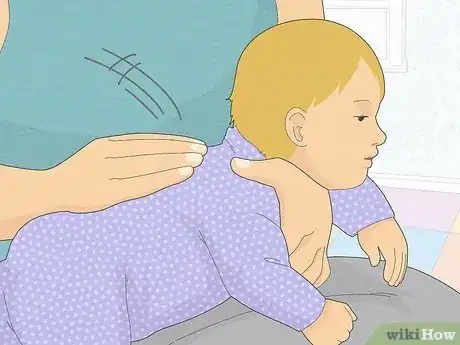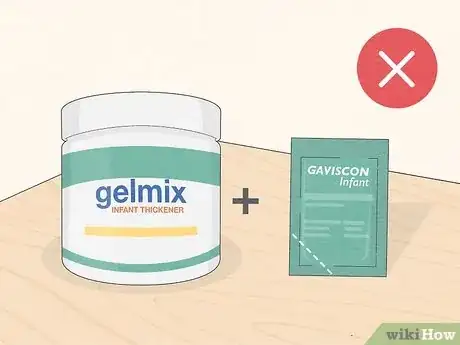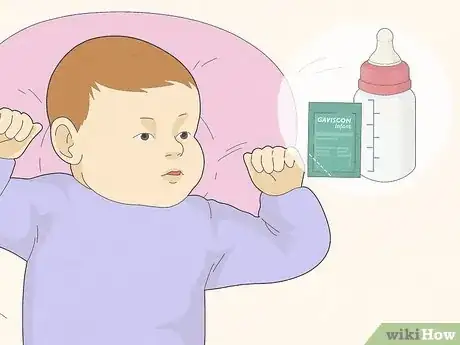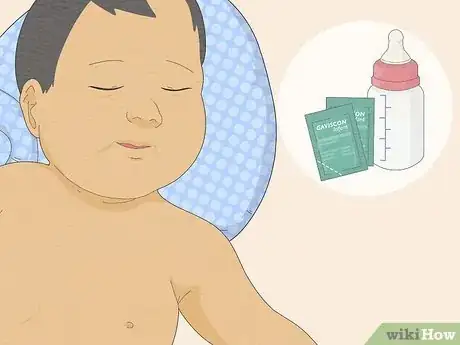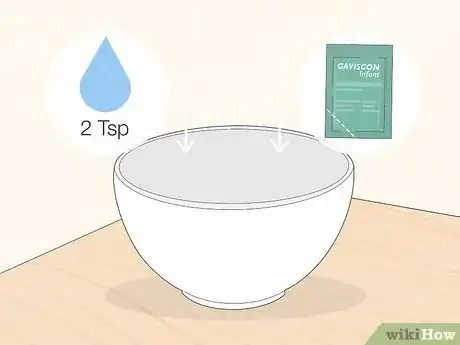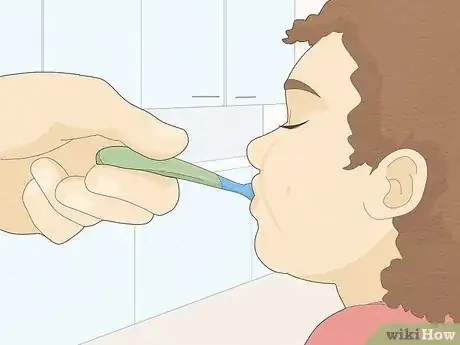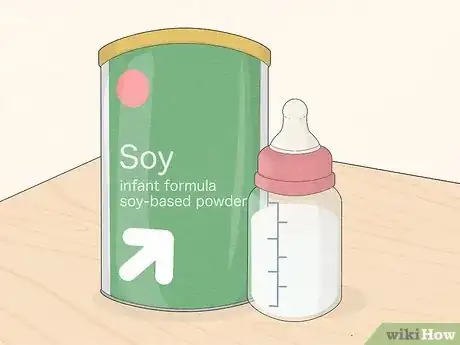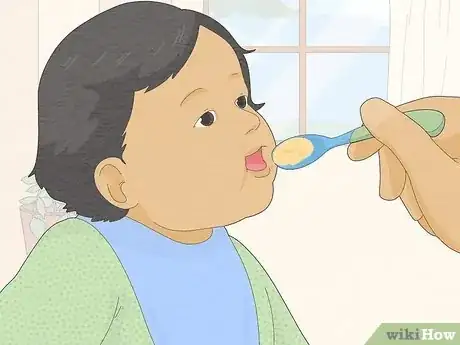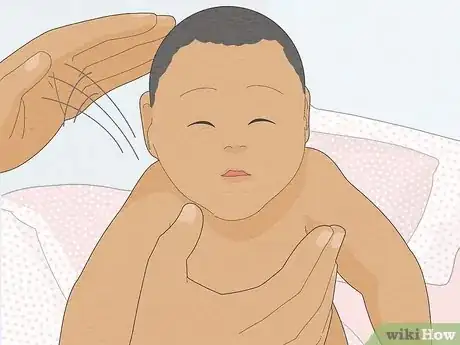This article was co-authored by wikiHow Staff. Our trained team of editors and researchers validate articles for accuracy and comprehensiveness. wikiHow's Content Management Team carefully monitors the work from our editorial staff to ensure that each article is backed by trusted research and meets our high quality standards.
There are 11 references cited in this article, which can be found at the bottom of the page.
This article has been viewed 27,498 times.
Learn more...
While it's normal for babies to spit up after eating (reflux), some experience heartburn, which may discourage them from eating in the future. Gaviscon, an antacid, may help with that, but you should take precautions before giving this medication to your baby. It's available in countries like the UK and Canada. Though it's not FDA-approved in the United States for children, your doctor may still suggest it if your child is having problems with heartburn. In addition, it's always a good idea to try a few feeding changes before turning to medications.
Steps
Taking Precautions
-
1Wait until your baby is 1 year old to use Gaviscon Infant. Unless directed by your pediatrician, Gaviscon should only be used for children over a year old. Your doctor can advise you if your baby is younger than a year and in need of heartburn relief.[1]
-
2Try other methods of soothing reflux first. While Gaviscon may help with reflux, it can also make fussy eaters fussier. Typically, a doctor only recommends this product if your baby is having pain or distress from reflux.[2]
- Some studies even question how helpful Gaviscon is for babies. It may provide some relief, but some studies show it is only marginally better than a placebo.[3]
Advertisement -
3Talk to your doctor before using Gaviscon. Your doctor can help you determine whether your baby's heartburn is bad enough to consider using Gaviscon. Also, they can help you decide on an appropriate dose for your baby.[4]
- Discuss the symptoms you've been noticing in your baby with your doctor. For instance, tell the doctor if your baby appears to be in distress after eating or is having trouble eating.
-
4Do not add Gaviscon to a formula with a thickener. Because Gaviscon Infant acts as a thickener, you shouldn't combine it with formulas that are already designed to be thick. You should mix these formulas as directed on the bottle.
- If you want to use Gaviscon in place of a thick formula, try adding Gaviscon to a formula of normal thickness.
Mixing Gaviscon into Formula or Water
-
1Use 1 packet of Gaviscon Infant for a baby under 10 pounds (4.5 kg). For a smaller baby, use a single packet as 1 dose. A single packet has 225 milligrams of sodium alginate and 87.5 milligrams of magnesium alginate.[5]
- Make sure you are using the infant version of this medication for proper dosing. Do not use adult versions without checking with your doctor. They are more difficult to measure for babies.
- Always talk to your pediatrician first about dosing.
-
2Add 2 packets for a baby over 10 pounds (4.5 kg). You can use a double dose for a larger baby. That means you'll be giving 450 milligrams of sodium alginate and 175 milligrams of magnesium alginate to a baby over 10 pounds (4.5 kg).[6]
- Again, talk to your doctor about dosing.
-
3Add the powder to cooled, boiled water for breastfed babies. Mix the powder into 1 teaspoon (5 mL) of water. Stir until it forms a smooth paste. Add in another 2 teaspoons (10 mL) of water, and mix it until smooth.
- Boiling the tap water is important because it removes any bacteria that may be in the water.
-
4Feed your baby the mixture with a spoon or syringe after you breastfeed them. Use a small spoon to tip the mixture in your baby's mouth. Alternatively, use a baby syringe or a dosing spoon. Feed the mixture to your baby a little at a time.
-
5Mix the powder into formula for bottle-fed babies. Add the powder directly into the mix when making your formula. For a baby under 10 pounds (4.5 kg), use at least 0.5 cups (120 mL) of formula. If your baby is over that weight, mix it into at least 1 cup (240 mL) of formula.
- Shake the mixture thoroughly after mixing the powders and water in the bottle.
-
6Make a bigger hole in a bottle teat or choose one with a faster flow. Gaviscon Infant may make it more difficult for the milk to flow through the teat of the bottle. You can use a sterile needle to make the hole bigger or purchase a teat with a larger hole to begin with.
- Loosening the cap on the bottle may also help.
- To sterilize a needle, try boiling it for 10 minutes.[7]
Minimizing Heartburn in Your Infant
-
1Try an alternative formula. In some cases, reflux may result from your baby having an allergy to cow's milk formula. In that case, switching to another formula may help reduce your baby's distress.[8]
- For instance, your doctor may recommend you switch to a hypoallergenic formula or a soy-based formula.
-
2Feed your baby more often. Feeding more often means your baby gets a smaller amount at a time. Reflux in babies often happens because they have too much milk in their bellies, so having smaller, more frequent meals can help.[9]
-
3Position your baby in a more upright position when feeding. When your baby is upright, gravity is working in their favor. That is, milk has less of a chance of coming back up. Keep your baby in this position directly after eating, too.
- Hold your baby in a position where they're sitting up and cradled in your chest. Keep them in this position for 30 minutes after eating.[10]
- You can also try the curved position. Support their back with one arm and wrap it around their legs, so their calves drape over your arm. You are cradling them in a "C" position, and their upper body should be mostly upright with their head slightly elevated.
-
4Burp your baby while feeding and directly after. Burping your baby helps them get rid of air in their stomach. With the air gone, there's more room for milk, meaning there's less of a chance of them spitting it back up.[11]
- The typical way to burp a baby is to hold them with their head facing your shoulder. Make sure to have a cloth to catch spit up, and gently rub or pat the baby's back.
-
5Keep the baby from moving around too much after feeding. In other words, don't bounce them up and down or move them around too much. Bouncing the baby around may worsen the effects of reflux.
- Burping, of course, is fine, just don't bounce the baby up and down on your knee or anything like that for about 30 minutes.
References
- ↑ https://www.medicines.org.uk/emc/product/6581/smpc
- ↑ http://www.netdoctor.co.uk/medicines/digestive-health/a6796/gaviscon-infant/
- ↑ https://www.ncbi.nlm.nih.gov/pubmed/15851425
- ↑ https://www.netdoctor.co.uk/medicines/digestion/a6796/gaviscon-infant/
- ↑ https://www.medicines.org.uk/emc/product/6581/smpc
- ↑ https://www.medicines.org.uk/emc/product/6581/smpc
- ↑ https://www.familyeducation.com/life/splinters/removing-splinter
- ↑ https://www.nhs.uk/conditions/reflux-in-babies/
- ↑ https://www.nhs.uk/conditions/reflux-in-babies/

